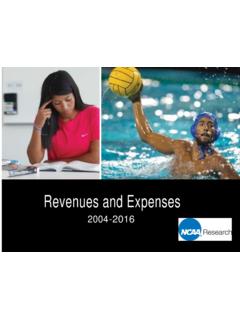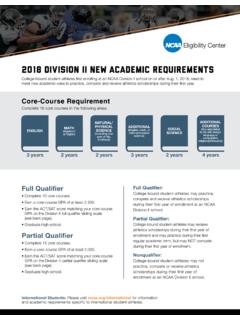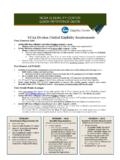Transcription of NCAA RECRUITING FACTS
1 DIVISION IDivision I schools, on average, enroll the most students, manage the largest athletics budgets, offer a wide array of academic programs and provide the most athletics 179,200 student-athletes 351 colleges and universitiesATHLETICS SCHOLARSHIPS59 percent of all student-athletes receive some level of athletics aidACADEMICS2017 Graduation Success Rate: 87 percent*OTHER STATSM edian Undergraduate Enrollment: 9,629 Average Number of Teams per School: 19 Average Percentage of Student Body Participating in Sports: 4 percentDivision I National Championships: 26 DIVISION IIDivision II provides growth opportunities through academic achievement, high-level athletics competition and community engagement. Many participants are first-generation college 121,900 student-athletes 308 colleges and universitiesATHLETICS SCHOLARSHIPS62 percent of all student-athletes receive some level of athletics aidACADEMICS2017 Academic Success Rate: 72 percent*OTHER STATSM edian Undergraduate Enrollment: 2,485 Average Number of Teams per School: 16 Average Percentage of Student Body Participating in Sports: 9 percent Division II National Championships.
2 25 DIVISION IIIThe Division III experience provides an integrated environment that focuses on academic success while offering competitive athletics and meaningful nonathletics 190,900 student-athletes 443 colleges and universitiesFINANCIAL AID80 percent of all student-athletes receive some form of academic grant or need-based scholarship; institutional gift aid totals $17,000 on averageACADEMICS2017 Academic Success Rate: 87 percent*OTHER STATSM edian Undergraduate Enrollment: 1,748 Average Number of Teams per School: 18 Average Percentage of Student Body Participating in Sports: 26 percentDivision III National Championships: 28*Graduation rate for student-athletes, including those who transfer from one school to RECRUITING FACTSC ollege sports create a pathway to opportunity for ,5003 DivisionsTeams490,000 Student-athletes1 AssociationWant to play ncaa sports?
3 Visit March the ncaa award athletics scholarships?Individual schools award athletics scholarships. Divisions I and II schools provide more than $3 billion in athletics scholarships annually to more than 150,000 student-athletes. Division III schools, with more than 190,000 student-athletes, do not offer athletically related financial aid, but most student-athletes receive some form of academic grant or need-based many high school athletes earn athletics scholarships?Very few, in fact. About 2 percent of high school athletes are awarded some form of athletics scholarship to compete in ncaa student-athletes have difficulty meeting graduation requirements with the time demands of their sport? While competing in college does require strong time-management skills and some thoughtful planning with academic advisors, on average ncaa student-athletes graduate at a higher rate than the general student many ncaa student-athletes go on to play professionally?
4 Fewer than 2 percent of ncaa student-athletes go on to be professional athletes. In reality, most student-athletes depend on academics to prepare them for life after college. Education is important. There are nearly half a million ncaa student-athletes, and most of them will go pro in something other than about ncaa sportsESTIMATED PROBABILITY OF COMPETING IN ncaa ATHLETICS BEYOND HIGH SCHOOL Men s Women s Men s Men s Student-Athletes All Sports Basketball Basketball Football Baseball Ice Hockey SoccerHigh School Student-Athletes 7,300,000 546,400 429,400 1,083,300 488,800 35,200 440,300 ncaa Student-Athletes 492,000 18,700 16,600 73,700 34,600 4,100 24,800 Percentage Moving from High School to ncaa 6% Moving from ncaa to Major Professional* 2% is a trademark of the National Collegiate Athletic Association.
5 Updated March 2018.*Percent ncaa to Major Professional figures are based on the number of draft picks made in the NFL, NBA, WNBA, MLB, NHL and MLS drafts.










